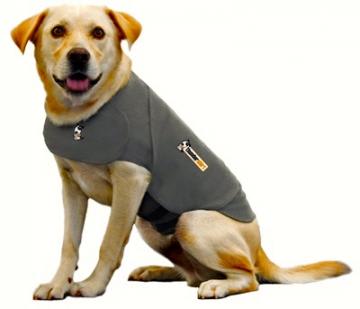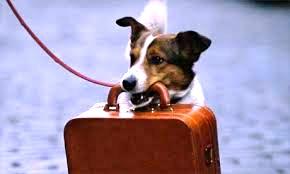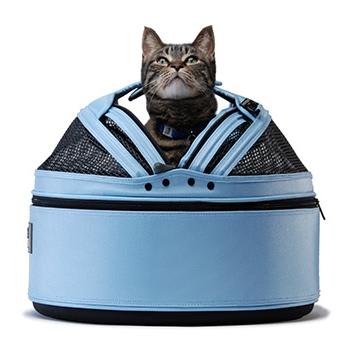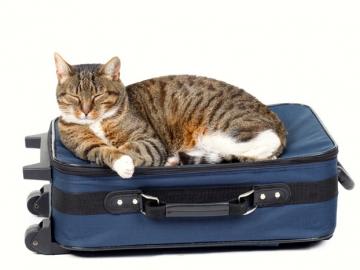Plan Ahead
1. If your pet is new to car travel, begin taking your pet on very short trips around town and give very small but frequent tasty treats as they enter the car and during the travel. Treats will work wonders for creating a positive experience with car travel. The use of frequent treats is not recommended for pets who experience motion sickness, however.
2. Make sure your pet is wearing a collar and ID at all times, and that it has a phone number you can reached at while you are on your trip. You can leave your pet’s home information tag on your pet and tape any temporary information that is needed to the collar, or consider having your pet wear, in addition to their home ID, a temporary tag during travel with your cell phone, destination phone number, and any other relevant contact information. Make sure your pet has a microchip (an identifying integrated circuit about the size of a grain of rice placed under the skin) and that the microchip registration is up-to-date and accurate. If your pet escapes the car in an unfamiliar place you are far more likely to be reunited with them if their registration is up-to-date.
3. Does your pet get carsick or anxious in the car? Motion sickness and anxiety are two different problems. Short term medications are available to decrease either or both. Ask your veterinarian here at Animal Hospital of North Asheville to prescribe the medication. We recommend giving any new anti-anxiety medication a “trial run” before the actual trip, to make sure the dose is correct and that it’s having the desired effect. For pets that are less anxious we have natural remedies or you can consider the use of a Thundershirt during the cooler months.
4. Turn off power windows that can be activated with the press of a paw. Pets can escape when they activate a window or even accidentally strangle themselves in a closing window.
5. Unless your pet travels frequently and has no motion sickness, your pet's travel feeding schedule should start with a light meal three to four hours prior to departure. If your pet has motion sickness, don’t feed on the day of the trip, but give a small amount of water.

Your Pet Travel Kit
What to pack for your pet:
- Water! Never travel by car on the interstate without water for your pet, especially in hot weather. Water is more important for your pet than it is for you in case you get stranded due to standstill traffic. In case of a long standstill, you may not be able to keep your car cool in hot weather and your pet will need to replace the fluid he or she loses by panting. Remember, your pet needs to drink frequently, especially in hot weather. In a hot weather traffic standstill, you can also use the water to wet down your pet to allow evaporation to keep your pet cool. Also, on the road and once you reach your destination, some pets get an upset stomach from unfamiliar water, which is another reason to carry some water with you.
- AHNA’s phone number. In case of an emergency in another city, give us a call. We always have your pet’s medical records on hand and we can send them to other veterinary hospitals if needed. Be sure to take vaccine records with you.
- Food
- Bowls
- Medications and first-aid kit
- Two leashes – have an extra in case you misplace one. Your dog should always be leashed in unfamiliar areas.
- Waste scoop and plastic bags
- Grooming supplies
- Favorite toys, pillows, or blankets
- Treats

General Tips
1. Instead of blasting the latest pop music, try playing classical music. If you are on a longer trip and need to play more upbeat music, then play it softly. Your pet’s ears are more sensitive than yours, and many types of music may stress your pet. There are CDs and portable sound machines that contain music that is made especially for cat and dogs to help decrease stress. Through a Dog's Ear and through a Cat's Ear produces music designed to calm your dog or cat that can be played in the car.
2. No smoking in the car with your pet!
3. Be aware of the temperature in your car. Temperatures that are too hot or too cold can be dangerous for your pet. Be aware of where direct sunlight is hitting and use a sunshield if possible. And remember that temperatures can vary drastically from the front of the vehicle to the back. The front of the vehicle cool and comfortable, but the back of the vehicle can be too hot for pets.
4. NEVER leave your pet unaccompanied in your car. Pets can quickly overheat or become too cold. Even if the weather seems mild to you, it can get dangerously hot or cold very quickly in a closed vehicle. More and more businesses welcome pets inside, so take them in with you or take your business elsewhere. It’s equally dangerous to leave your pet unsupervised in your car with the keys in the ignition. Leaving them with the air conditioner running is also poor protection from overheating as many car air conditioners are programmed to cut off after a period in park or even blow hot air if the car begins to overheat. Also, dogs have been known to lock themselves in the car or even unintentionally put the car in drive or reverse.
5. Keep your dog’s head inside the window. Although it is undeniably adorable to see a dog enjoying the breeze while speeding along the highway, many things can happen while a dog has his head out the window:
- Dogs may jump out of the window
- They can be hit by flying objects
- Bugs, dirt, etc. can become stuck in your dog’s eyes and ears
- Wind exposure can dry out the eyes
- Wind and cold air can cause inner ear damage and lung infections
Crates and Harnesses

Your dog and cat should be restrained in some way while you are driving. There is nothing more dangerous than a pet roaming the car while you are trying to concentrate on driving. Never transport a pet in an open-bed truck. It is illegal in Buncombe County to transport a pet in an open truck unless they are properly secured, but even properly secured it is very dangerous. We have seen many injuries that could have been avoided.
- Dogs and cats should never be kept in your lap while driving for a number of reasons:
- If you are in an accident, your pet would very likely be killed by the airbag, which deploys at over 200mph. For this reason, pets shouldn’t be in the front passenger seat either.
- If you slam on the brakes your pet could hit or go through the windshield.
- Pets like to wiggle and move around, which is a distraction when you’re driving.
- A pet held in your lap while you’re driving could inadvertently hurt you. If your pet is startled by something she could bite or scratch you, once again distracting you from driving.
- If you use a crate, be sure that it is in the back of your car and that it is secured so that it doesn’t shift around while the vehicle is moving. Crates should be well ventilated and your pet should be able to stand, lie down, sit, and turn around in the crate. Many cats prefer to have the carrier covered because it allows them to be hidden and feel safer, but be sure to use a light weight covering so that air can circulate. Click Here for a helpful brochure on traveling with your cat.
Be sure to research car harnesses before purchasing one for your dog. Many car harnesses offer no protection to your pet. We recommend Sleepypod products.
You may also want to consider a backseat travel barrier. This partition fits between the two front seats of the car and prevents your dog from making her way to the front seats while you are driving. It also acts as a safety barrier if you are in a car accident while your pet is in the car.
A little planning can go a long way toward keeping you, your family, and your pet safe while traveling!


